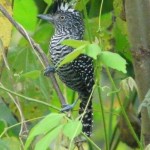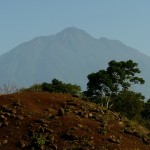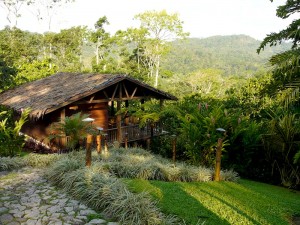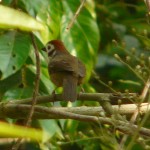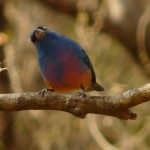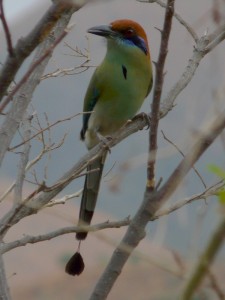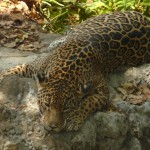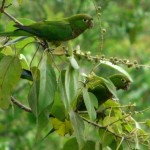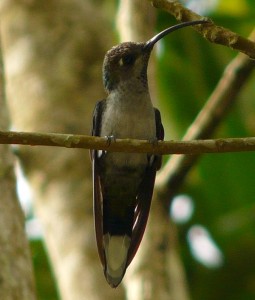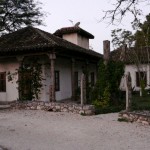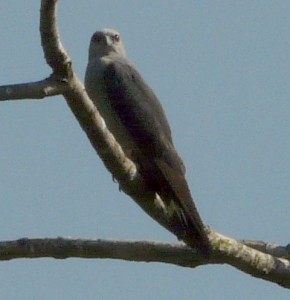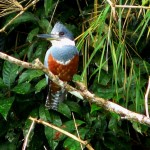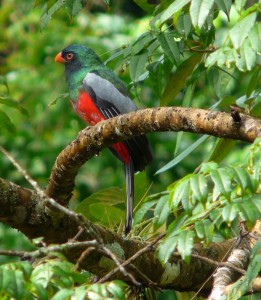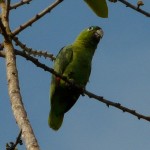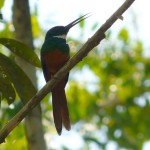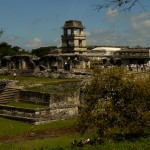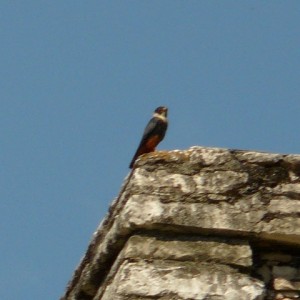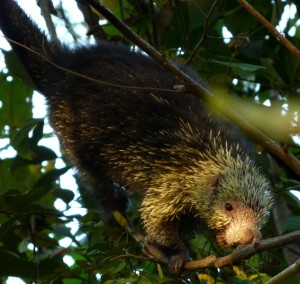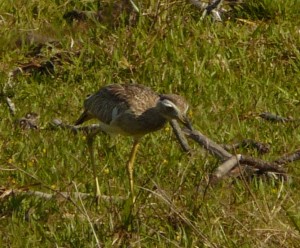This year we ran two very different tours to the fantastically diverse and beautiful state of Chiapas, a state that is home to no less than three-quarters of the entire countries avi-fauna. The first tour focused on the foothills above the Pacific coast with a couple of days in the highlands around Tuxtla Gutierrez. The second and longer tour started in the Tuxtla area and headed into the highlands around San Cristobal de Las Casas and the cloud forest of Lagos de Montebello before dropping into the Lacandona lowlands along the Guatemala border and ending in Palenque. The dry season turned out to be over, or certainly interrupted, as we had a fair bit of rain throughout both trips, as well as a couple of chilly mornings in the higher elevations. This made for fewer flowers and maybe slightly reduced bird activity. We still managed to find 384 speices in the two combined tours and that was without ever visiting a coastal area!
After nearly three days of scouting, our driver, Rafa, and I, picked the first group up at the Tapachula airport. Off to "El Navegante" for a nice seafood lunch and the biggest chicken soup I have ever seen. I was glad that Eileen was forced to eat it and not me! Free beer came out in a rather confused manner and surprise… it all ended up being consumed!
Then it was off for some afternoon birding. Unlike the previous afternoon it was WARM. A few miles down the dirt road directly opposite of the turn to Puerto Chiapas, we finally got some birds. Highlights were the Turquoise-browed Motmot, White-throated Magpie Jays, Ferruginous Pygmy Owl and a lot of Wood Storks.
At the port, we got better looks at the White-bellied Chachalacas and a few hundred pounds of Gray-breasted Martins up on the high tension wires.
A raucous dinner at the plaza was filled with marimbas and singing midgets and a fantastic steak dinners that topped off the evening. Nothing like a singing midget at your table to get a trip off to a great start! Our first night was spent at the funky and wonderful hotel Casa Boutique Mexicana in downtown Tapachula, a very nice little hotel full of fantastic Mexican crafts and some really nice fine art.
Day 2 - Today we slowly made our way up the volcano Tacana perched right on the Mexico-Guatemala border, but first stopped at the campo experimental just outside of town. Here we were treated to one of Rafa’s nice field breakfasts, while we got our first looks at a variety of forest birds. Giant Wren nearly the minute we got out of the van. Then we went after a few Blue-crowned Motmots that were singing their heads off, but never got more than fleeting glimpses of them. We made it to the volcano in the fog but by then things got pretty quiet and we really only got looks at a number of White-eared hummingbirds and an Orange-billed Nightingale Thrush before calling it a morning and heading down the hill for lunch.
We had lunch at a nice little place below the volcano, "Las Alcatrazes", where we had a very cooperative pair White-collared Seedeaters building a nest.
Just after lunch, the rain set in and we were treated to an intense storm for the entire 1.5 hour drive to Finca Argovia. The streets of Tapachula were running 2 feet deep with water in some places! The rain let up as we were getting close to the Finca, but as we pulled into the driveway the sky opened up again. We were greeted with strawberry ice cream upon arrival at Finca Argovia and opted for waiting out the rain rather than make our way directly to the rooms. In the mean time, we caught up on the bird list and had a few drinks at the bar!
Day 3 – We birded the finca grounds which proved to very good for the entire morning and did a recon trip up to Guadalupe and
got a Townsend's Warbler, hardly worth the time an effort that it took to get up to the pines on the first big ridge. However I think everyone enjoyed going up there and the vistas of the fog filled canyons was quite spectacular.
Day 4 – We birded the lower road to the property and got some great birds, even though it was not nearly as birdy as the day before. Highlights of the morning included the two or three Central American Pygmy Owls that seemed to come into within a few feet of us but were never seen! Several good looks at Prevost’s Ground-sparrow and a Blue-tailed Hummingbird perched above our head. After birding we had a nice brunch at the hotel before packing up and heading to Arriaga. On the way we made a birding stop outsde of the town of Mapastapec where we were treated to a nice pair of Barred Antshrikes and a great fruiting fig tree that happened to be just over a fence from our lunch spot! As Rafa was setting out lunch, a pick-up truck came by and literally “dropped off” a guy (maybe Steph’s Dad?!) who had apparently been having a bit too much fun in town. Although it really wasn’t that funny, the whole scene was a little hard not to laugh about! There were birds everywhere and even more in the big fig tree next to the lunch site that Rafa picked out. Arriaga on the way we got Snail kite, and made a stop on the road to Puerto Arista where we got White-faced Ibis and trees full of Limpkins. I love these little hotel restaurants that do such a good job. The Hotel Ik-Lumaal has a great menu (and it has English too!)
Day 5 – After a quick breakfast in the guide's room, we were off to
explore the “Sepultura” reserve. As is typically the case for this area the brids were cooperative an numerous. On the drive out we were treated to great looks at an incredible number of Russet-crowned Motmot’s and once at my favorite spot, we got both the Rosita’s and Orange-breasted buntings fast and in good numbers! We also got good looks at Green-fronted Hummingbird but dipped on the Lesser Ground-Cuckoo a bird I almost always get there. Then it was back to the hotel for lunch before the drive up slope and north to the Cima de Los Cotorros. The Cima was cool, lots of Green Parrakeet’s and a bat falcon that got them all excited every now and then. We also had our first White-eyed Vireo and a Flammulated Flycatcher was calling but tough to see. Then it was on to Tuxtla Gutierrez for the evening.
Day 6 - I got a big surprise as we landed at Canyon Sumidero for our morning birding. The road to the top had been closed for road work and they were not letting anyone go up to the overlooks! This was not good! There were a couple of birds up there that we would have a hard time finding elsewhere. We decided to just walk the bottom section where they would not allow cars, and look for birds while Rafa worked his magic with the head guyof the reserve. It all sort of worked out. We got good looks at Red-breasted Chat and Rafa got permission to drive up to pick us up! Well once we were in there no one was around to stop us from continuing on to the top! Once we made it around a couple of serious construction sites we made it to the third overlook where we did a little walk to the rim. Birding was pretty good up high, although getting there kind of late certainly caused us to miss a couple of things. At one point we did get a Vermiculated Screech Owl to answer back, but it never came in. Then we were off for lunch at the Jardines de Chiapa where we were treated to a nice Marimba band as we lunched. After lunch it was off to the highlands for last shot at the Pink Headed Warbler for the mid-west crew. After a lot of work we got looks at the Mountain Pygmy Owl but dipped on the Warbler and we were treated to great looks atdozens of Rufous-collared Robins.
Day 7 – Today we said goodbye to most of the group after a short but great tour! There were a lot of high points for me on this tour. Staying and birding at Finca Argovia, eating on the plaza in Tapachula that first night and seeing so many Russet-crowned Motmots outside of Arriaga.
The rest of the day was pretty much a chance for us to re-group and get ready for the next tour, but Glenn, Rafa and I decided to head on ove to the Tuxtla Zoo, which turned out to be a a wonderful experience. I had always
wanted to go to the Tuxtla Zoo, but had never had the time until this trip. I think from now on I will find a way to incorporate it into all the Chiapas tours. We spent more than three hours checking out the exhibits and wandering around the grounds and exhibits which are well done and very interesting.
Day 8 or 1 – The weather got rough during the night and the wind was blowing like crazy it brought in some sort of cold front that apparently was affecting the entire Yucatan peninsula and in the morning we woke to rain, fog and more wind. I was ready to deal with all of the bad weather while birding, but when the traffic on the highway came to a dead stop on the drive to the birding spot I knew we were in for some bad luck. We waited in the line of stopped traffic for about 30 minutes before I realized that we should just go somewhere else, we were just wasting good birding time. We found a cool road just a few miles back to the west and birded it for a while, hoping that the road would get opened and we would be able to continue on to Ocote. Once we covered the entire road we made one more try at getting through where the traffic had been stopped, but after a short wait this time we decided to abort the mission. Rafa did some quick checking of the map and found a minor route that would reconnect with the spot we wanted to go without taking the main highway. The road worked perfectly and we eventually got to the spot where I wanted to bird. We birded on and off in intermittent showers that went from mist to downpour, but we still managed to get some birds. Then I heard the unmistakable call of a Nava’s Wren and I began with a bit of playback. The bird responded immediately
and eventually came up to a large rock right in front of us and bounced and sang for us for several minutes. It was awesome! After a field lunch, we were off to another spot across the highway called Rio Frances. We had good looks at Aztec Parakeets on the way down and a pair of Rusty Sparrows on the way back up.
Day 9 or 2– Today we went back to Ocote in far better weather than the day before. We had a great morning with tons of birds: Stripe-tailed
Hummingbird, White-bellied Wren and Golden-crowned Warbler. In the afternoon, at the Cerro outside of San Cristobal de Las Casas we finally got an OK look at Blue and White Mockingbird and a fleeting glimpse of White-napped Brush-finch and Band-backed Wrens. Our night in San Cristobal was nice at the Hotel Diego de Mazariegos.
Day 10 or 3 – This was our last chance for Pink-headed Warbler and as bad luck would have have it we dipped on it once again. We gave it a hard long try looking in three different locations but it just never showed itself. We did have some amazing Warbler flocks along the way, finding a number of great ones including Crescent-chested and Olive. I'm guessing that the cold front had something to do
with the lack of Pink-headed Warblers, at this time of year they should have been far more conspicuous. We were fortunate to sneak around a rather serious storm but were treated with views of a couple of inches of hail that had accumulated on the side of the road just as we dropped down in elevation! We had a nice lunch in downtown Comitan at the Café Portales before a quick stop at Walmart and then heading on to the beautiful Parador Santa Maria for the night. This hacienda is a 200 year old home that has been lovingly restored by one of the surviving family members. The restoration is well done, but not over done and the place retains an old feel that is hard not to appreciate.
Day 11 or 4– We got out of the hotel early for the quick 20 minute drive to the Lagos de Montebello reserve where Rafa set us up a great field breakfast which we wolfed down before our hike into the cloud forest. It was wet and cold after yesterday's heavy weather and this kept the bird activity to a minimum until things warmed up. Interrupting our breakfast was a pair of Black-headed Nightingale Thrushes who gave us some great looks while we finished up the last of the yogurt.
Day 12 or 5 – Today we spent the entire morning walking the road to Cinco Lagos where we had some good luck with some hard to find birds. Finally we found both Black-throated and Uni-colored Jay way over head in the pines but we eventually tracked them down. We also had luck with Blue-throated Motmot and heard a Resplendant Quetzal. The afternoon was a longish drive down towards the Guatemala border and Las Guacamayas. We made a number of stops along the way, one of the most productive was at KM 305 where we encountered the recently discovered population of Gray-breasted Crakes and we saw Blue Seedeaters,
Plumbeous and Missisippi Kites. Las Guacamayas is a neat eco-tourism project right on the La Cantun River, that gives youm great access to great birds, pretty much right out the front door. Tonight we were treated to yet more rain, and at times quite strong! At one point the power went out and we were told not to expect it to come back on. The power went out at the same moment that my spot light died while we were attempting to get looks at a Vermiculated Screech Owl that seemed to be calling from accross the river. I must say that this ranks up there with one of the most embarrassing moments in mybirding life when I realized that the call I was hearing accross the river was not a Vermiculated Screech owl at all! It was a chorus of hundreds of frogs! Now, I still swear to this day that thsoe damn frogs sound almost identical to the Owl, but there is a slight difference which is VERY obvious to me now!
Day 13 or 6 – This morning was our one chance to do the boat trip on the Rio Cantun, but just before my alarm went off we were treated to an amazing downpour which didn't make the idea of boating sound all that inviting. We waited it out for a while and nearly at the time we had told our boatman to arrive, the rain stopped and we were off for some birding. Right off the bat, we got looks at what appeared to be a harem of Great Curassows hanging out with a few Creasted Guans.
The Great Currasows numbered 4 females, including a Barred Morph and a male in the tree. Then we started to see Kingfishers, Amazon and Ringed were the most common but eventually we got looks at all 5 kingfisher species that one can find in north America, including a rather confiding American Pygmy Kingfisher! Other highlights were great looks at Crested Guan, Aplomado Falcon, Black-faced Grosbeak and Gray-necked Woodrails. We heard Scarlet Macaws fly over, and Eileen actually got to see a flock of 8 go over the hotel area.
The afternoon was spent driving three hours to Fronterra Corrizal on the Usumacinta River.
Day 14 or 7 – The breakfast bell rang early today and we were off to meet the boatman before the arranged time of 5:45 a.m. I had noticed during the night that the rain had stopped and I was optimistic that we would have good weather this morning. After a bit of morning fog that burned off quickly it was obvious that we were in for a beautiful day. There is nothing like Yaxchilan at sunrise when there are no other people around! l am happy that the rest of the world does not know the benefit of being there EARLY. I was only a bit concerned that the booth to buy tickets was closed when we got into town the previous day. Typically we have to get tickets for an early departure the day before. Rafa assured me that he would work it out and not to worry about it. Sure enough once we were at the ruins, the guy who watches the place and has lived there for 22 years was chatty and
asked us what we knew about the earthquake tsunami in Japan. It turned out he knew more than us! He was very nice and
“sold” us tickets (that I never saw) to get into the ruin for 200 pesos. If I had bought them at the office in town it would have been 300, so it seemed like a good deal! Right off the bat, we were hearing Spotted Wood-quail calling everywhere, and lots of other song coming was out of the jungle. In the first light of the day, seeing things other than shapes in the forest was difficult. Eventually, the sun came up and we started to see lots of birds. Slaty-tailed Trogons gave us an amazing show as they picked termites out of a nest. A Mealy Parrot perched out in the sunshine for all to see, and a flowering Bombax tree at the top of the grand Acropolis was a feeding frenze of Green Honeycreepers, Hummingbirds, Warblers, Pale-billed Woodpeckers and a number of Tanager
species. It was easy to spend three plus hours enjoying the ruins and looking for birds. On the way back to the boat for the ride home I called in a Rufous-tailed Jacamar
and while we were enjoying that, Eileen found a Dot-winged Antwren lurking around in the bushes in front of us...a fine way to end the morning.
After a quick lunch back at Escudo Jaguar,we were off for the 3 hour drive to Palenque and our last three nights at night at hotel Chan Kah, at the gates of Palenque.
Day 15 or 8 – We got to the parking lot at the ruins of Palenque just before the gates opened and already there were buses of tourists arriving to get in. Nearly immediately after entering the ruins, a Bat Falcon passed overhead carrying an unfortunate Red-legged Honeycreeper in its talons! As Andree and I birded the edges of the cleared areas, Glenn and Eileen worked the grass for butterflies. Eventually we ended up working the same
patch and I decided to try a little tape for Black-faced (Mexican) Ant-thrush. I admit that it was a bit of a 'Hail-Mary' attempt, but almost immediately I got a response from one down in a maintenance area. We made our way down the trail towards the response of the bird and eventually got to within 20 feet of where we could hear the bird singing. Just as it looked like the bird was about to come out, I saw some movement in the bushes and for a second thought that we had run into another birder! It turned out just to be some Italian hippie who had snuck into the ruins without paying! The good news was that his passing within precious little feet of the bird did not seem to disturb it at all and it continued to respond to playback. Eventually, with a little repositioning and a bit of luck, the bird came out into plain view on a small trail and looked both ways before darting off into the forest. Better than average looks at the very special species.
But there was a lot more to be seen at Palenque and we had just scratched the surface. We popped out of the restricted maintenance area (oops) in front of a fig tree that was in full fruit and full of birds. My rough count of what we saw in the hour and a halt that we were in front of that tree was over 30 species, not including the Solitary Eagle and the Great Black Hawk that flew over while we were staring into the tree. It was a wonderful way to spend the morning.
After the tree we took some time to explore some more of the archeological site before hoofing it down the 300 stairs to the parking lot below where Rafa was waiting for us.
This afternoon we took a little break before taking the 45 minute drive out to Laguna Catazacapan which is home to Manatees and where we were hoping to get a look at a Black-collared Hawk and maybe a Bittern or two. Well, it turned out that Glenn did get the Hawk, but the Bittern would have to wait. After birding the shores near town we went to the other side of the lake where I was planning on visiting a spot that had been pretty birdy in the past. This time the gate to the area was locked but just as I
was about to go somewhere else the owner of the adjacent property drove up and encouraged us to following him out to his 20 acres even farther out. It was a beautiful piece of property with lots of birds, including the first Ovenbird of the trip. The owner, Eduardo was a very interesting man who is committed to protecting this remnant plot of forest on the edge of the lagoon, he was very accommodating and happy to have us as visitors. I think the high point of the afternoon for all of us had to have been seeing the Mexican Porcupine that Eduardo told us had a den on his property. On our way out of his ranch we followed him to a short trail into the forest and a tree with a big hole in the side of it. He began to stick his machete into the hole attempting to wake on the sleeping guy inside. In a couple of minutes, the absolutely adorable little animal came slowly out of the hole and made its way up the tree and out of harms way.
After supper we went out ot see if we could turn up an owl or two. Immediately we got the calls of Common Paraques in the adjacent field and eventually got to see them sitting on the ground. Then came the Vermiculated Screech Owls that did call back and eventually got closer but never showed themselves, the same was true for the Mottled Owls that came even closer.
Day 16 or 9 – The Usumacinta marshes are a vast flood plain that is constantly ebbing and flowing depending on the size of the river of the same name. Typically, the spring is dryer and the birding is mostly checking the rice and other agricultural areas that have been flooded with irrigation water. When water and conditions are right this area contains enormous numbers of water fowl and other birds. As is typically the case, we had to spend a fair bit of time exploring some historically good areas before we found one that was right for the birds we were looking for. Along the way we were treated to a few other good birds including wonderful looks at Double-striped Thick-knee. But the bird we were looking for nearly all day was the Pinnated Bittern, a life bird for everyone and one of the specialties of the area. I had nearly given up after we had scanned several 100 acres of flooded rice at our last stop in the heat of the day, it was starting to look like we would dip on the Bittern. With precious little rice left to check, Glenn heard a Bittern “pumping” in the distance and Andree and I hoofed it back there to help him try to find it. Nearly immediately after getting to Glenn, I saw a Bittern standing on a small irrigation ridge about 200 yards back from the road! I quickly got the scope on it and after the bird finally moved its head I saw that indeed it was a Pinnated! We all got great looks before the bird took off flying and then landing even closer, where we all once again got even better looks. Always nice to end a tour with a great bird!
Day 17 or 10– This morning was our trip to Villahermosa and the end of the tour. We got Andree to her flight with time to spare and the rest of us went out to look for birds and butterflies for the remainder of the morning. There were more butterflies than we had seen for many days, although the numbers were still pretty low. Bird-wise, we added a few birds to the trip list at the marshes, but nothing out of the ordinary. I have to say that this tour to Chiapas was certainly the highlight of my Spring, and I want to thank all of the participants for making it a success!
